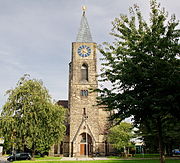Philosopher Quarter
The Philosophenviertel is a district in the Hanoverian district of Kleefeld .
Location and shape
The quarter is of a wedge-like shape and has a west-east extension of about two kilometers and a north-south extension of about 250 meters. It is bounded by the street Am Pferdeturm in the west and by Kirchröder Straße in the north and east. In the south it borders directly on the Eilenriede city forest . It is criss-crossed by streets named after philosophers such as Immanuel Kant , Johann Gottlieb Fichte , Georg Wilhelm Friedrich Hegel , Arthur Schopenhauer or Baruch de Spinoza . The development of the district is characterized by high-quality single-family houses and around 170 villas, some in country style. The quarter is counted among the “most privileged living conditions” in Hanover.
history
The quarter emerged as a result of the construction of the Petrikirche in 1899. Many wealthy Hanoverians found it too cramped in the city, especially in Ernst-August-Stadt , and they founded villa colonies in the most desirable outskirts of the city, all around them Urban districts such as Kleefeld developed in this case. At the beginning of the 20th century, numerous Wilhelminian and Art Nouveau villas such as the Villa Effertz were built in Kleefeld, which was incorporated into Hanover as early as 1859 . Many of the houses that were built at that time are now listed . The election results for the NSDAP in Kleefeld in the early 1930s were below average compared to other cities with around 17 percent of the votes, which Richard F. Hamilton - compared to the other NS-inclined Hanoverian villa districts such as the Hindenburgviertel or Waldhausen - explains that in the northern part of the socially mixed Kleefeld lived many workers, which is supported by the consistently high proportion of the SPD with over 50 percent.
Resident institutions
At the west end on Dörriesplatz is the Petrikirche. The Alice-Salomon-Schule is in the middle , the Stephansstift forms the east end. The Lower Saxony Veterinary Association and the Independent Evangelical Lutheran Church are based in the district .
Web links
supporting documents
- ^ Klaus Mlynek : Kleefeld. In: Klaus Mlynek, Waldemar R. Röhrbein (eds.) U. a .: City Lexicon Hanover . From the beginning to the present. Schlütersche, Hannover 2009, ISBN 978-3-89993-662-9 p. 350 .
- ↑ Michael Vester , Peter von Oertzen , Heiko Geiling, Thomas Hermann, Dagmar Müller: Social milieus in social structural change. Between integration and exclusion (= Suhrkamp-Taschenbuch Wissenschaft Vol. 1312). Suhrkamp, Frankfurt am Main 2002, ISBN 3-518-28912-8 , chapter “Dimensions of a socio-spatial structure: Social situation and urban density in Hanover.” Pp. 296-310, here p. 300.
- ^ Adelheid von Saldern : Urban periphery living . Social inequalities from a historical perspective. In: Annette Harth, Gitta Scheller, Wulf Tessin (ed.): City and social inequality. Leske and Budrich, Opladen 2000, pp. 79-101, here p. 86 .
- ^ Richard F. Hamilton: Who Voted for Hitler? Princeton University Press, Princeton 1982, p. 206 .
Coordinates: 52 ° 22 ' N , 9 ° 48' E


